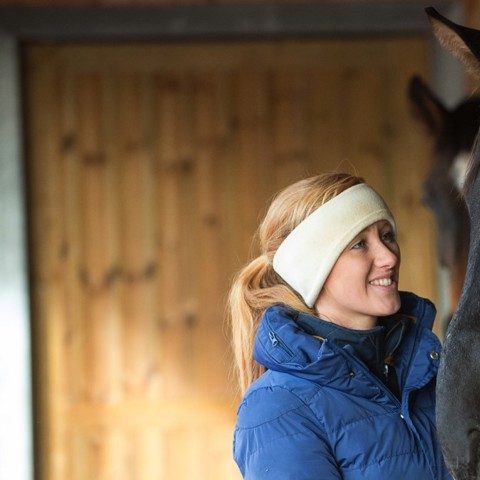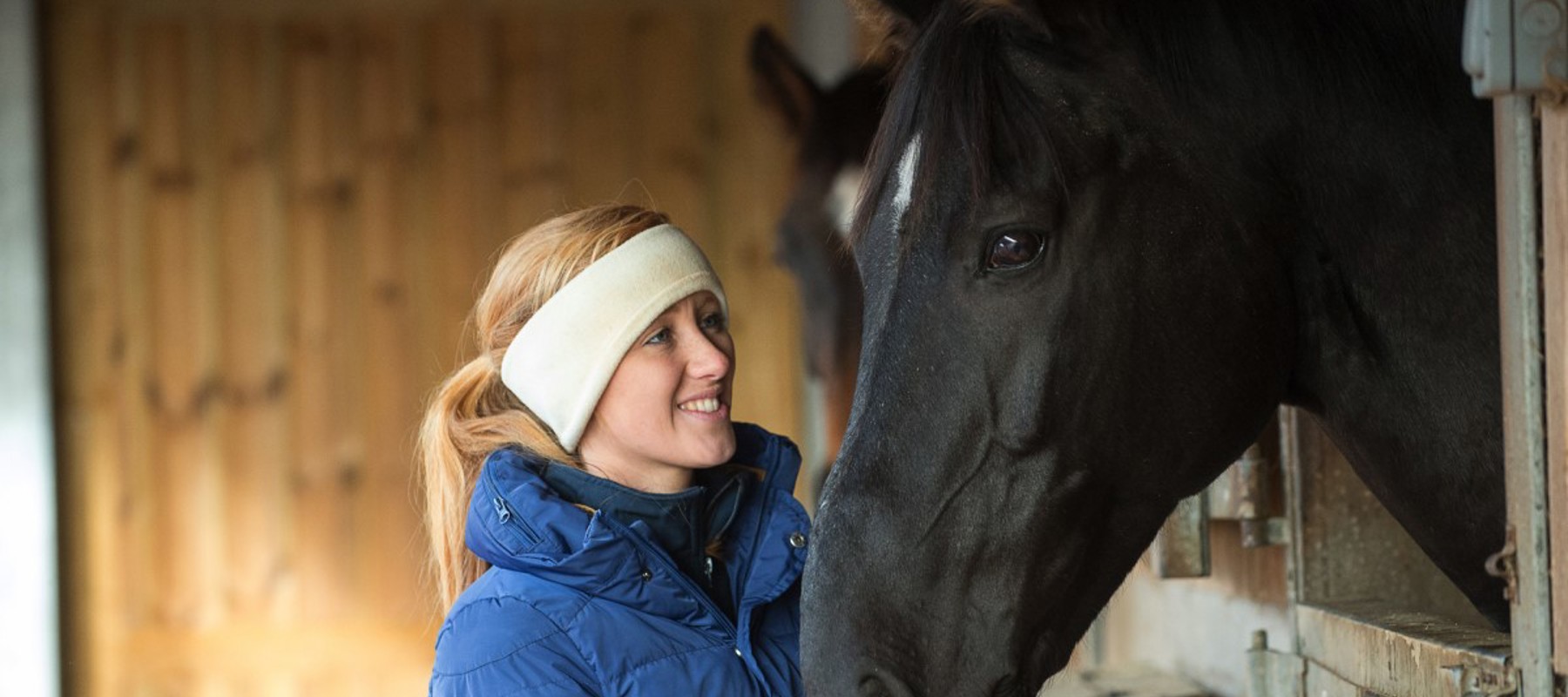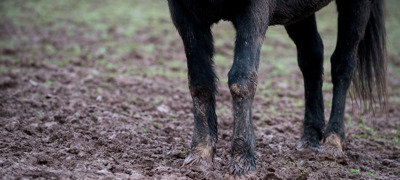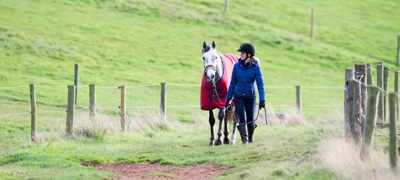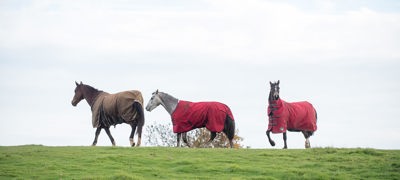Seasonal changes may mean your horse requires extra care and attention to stay both physically healthy and mentally stimulated to meet their behavioural needs. It’s natural for your horse to lose some weight over the winter months, which is helpful if your horse is overweight. If your horse is already at a healthy weight you may need to adjust their routine to help them maintain their condition.
Feeding forage
Forage should form the basis of any horse’s diet as they’ve evolved to chew for up to 18 hours a day. It’s important to provide enough forage to help satisfy their nutritional and behavioural needs, especially during winter when grass may not be readily available, or turnout time is restricted1. Forage acts as an in-built heating system and keeps horses warm by creating heat as it breaks down the fibre in their digestive system2.
You may need to give your horse extra forage in the field, especially if there isn’t much grass available. When putting hay out it’s a good idea to make sure there are more piles of hay than there are horses to help avoid conflict. This makes sure everyone gets a fair share.
To help reduce waste, you might want to use hay feeders. These help keep the hay off the muddy ground, making it cleaner and easier for horses to eat. They also stop hay from being trampled or blown away, so less goes to waste. Try to place hay or feeders away from water troughs and gateways, as these areas can get muddy and worn down quickly.
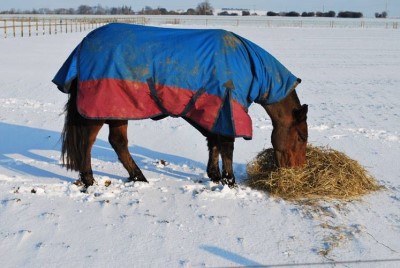
Feeding — does your horse need more than just forage?
Many leisure horses do well on a forage-based diet, but it’s difficult to know exactly what vitamins and minerals they’re receiving unless you have your forage tested. Adding a balancer or vitamin and mineral supplement daily can make sure your horse gets what they need.
Additional feeds
chevron-down
chevron-up
There are times when additional feeds (concentrates) would be beneficial, for example for elderly horses who struggle to chew forage or those who lose an unhealthy amount of weight during winter. Talk to a nutritionist to find out if your horse would benefit from this to help avoid overfeeding and save money by not buying unnecessary feed.
If concentrate feeds are needed, give them little and often so they can start to be broken down effectively by the stomach. As the stomach is relatively small, any concentrates that are fed in large amounts can pass unprocessed through to the large intestine which increases the risk of colic and other health issues.
Monitoring weight
chevron-down
chevron-up
Using a weigh tape, alongside fat scoring every two weeks, will help you to monitor your horse’s weight. Weigh tapes can vary in accuracy and may not be reliable for overall weight but they’re a good tool to help monitor if your horse is maintaining, losing or gaining weight. This way you can keep a close eye on any changes and adjust feeding programmes if needed.
If you have access to a weighbridge, this will provide an accurate weight for your horse. We offer owners and carers the opportunity to weigh their horses by bringing a weighbridge to your yard. Your vet practice or local feed company also may offer this service.
Rugging
It can be tempting to rug horses, especially when we feel cold ourselves. However, horses don’t feel the cold like we do and will naturally grow a thick winter coat, so it’s important to assess whether rugging is necessary.
If left un-rugged, try not to overgroom horses as this can strip the coat of natural oils which help with waterproofing, although it’s still important to remove any mud from areas where tack will be worn to prevent rubbing.
Keeping hydrated
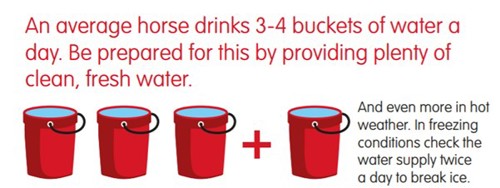
Water plays an important role in hydration and digestion1. If your horse doesn’t have access to enough water, is unable to drink as the supply has frozen or doesn’t drink enough water, it can affect how food passes along the gut and increase the risk of impaction colic2.
· Fill up containers to make sure you have access to an emergency supply of clean, fresh water in case taps freeze.
· Add warm water into water buckets to prevent them from freezing overnight. This can also encourage your horse to drink if they don’t like the colder water.
· If you have an automatic water drinker, check the pipes are well insulated. Alternatively, provide extra buckets of water, just in case.
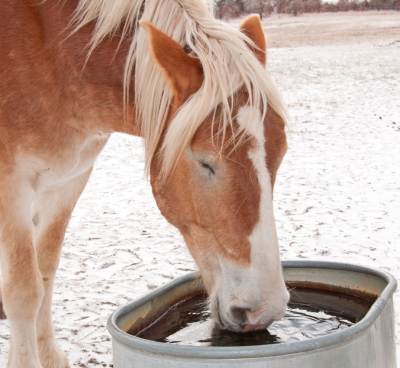
Winter ailments
Winter can increase the risk of your horse developing certain conditions, especially due to wet and muddy and indoor environments.
Common winter ailments include mud fever, rain scald and equine asthma.
Changes to routine
Turning horses out all summer and then housing them at times during the winter is common practice at many yards. This adjustment in routine represents a significant change to the horse’s diet and management, so should be completed gradually over 10–14 days to help reduce the risk of colic.
With fewer daylight hours and poor weather to deal with, it can often be a challenge to maintain your horse’s fitness. Some owners decide to give their horses a rest period during this time or ride significantly less. It’s vital that time and care is taken during this process.
It’s possible your horse will be spending longer periods housed. Providing extra enrichment can also help to enhance their behavioural needs.
Turnout
Wet weather often results in fields becoming poached and muddy but there are steps you can take to help protect your pasture and manage the mud.
Shelter
chevron-down
chevron-up
When out at grass, horses will need access to shelter, either natural such as thick hedges or tree lines, or a field shelter (planning permission requirements can vary between authorities for temporary, moveable or permanent field shelters)2. Even if you think your horse doesn’t use it, on a cold, windy day they’re likely to seek a wind-break3.
If natural shelter is accessible in your pasture, it’s important to make sure this isn’t poisonous to your horse. Consider any trees that lose their leaves during winter, making them inadequate for providing shelter.
Keeping horses active in winter
During the colder months, you might need to reduce turnout time to protect the fields from getting too muddy and to help prevent winter-related health issues. However, it’s still important for horses to get outside every day.
Spending long hours in the stable can limit your horse’s natural behaviours like moving around freely, foraging and socialising. This can lead to boredom, stress and even unwanted habits.
To help keep your horse happy and active, include time out of the stable in their daily routine. This could be hand walking, lungeing, riding or driving, turnout in a designated area such as an enclosed arena or using a horse walker. These activities give your horse a chance to stretch, explore and stay mentally stimulated.
Ground conditions
chevron-down
chevron-up
Ice and frost can cause many hazards. Gritting concrete areas around your yard will prevent you and your horse from slipping. Don’t ride out in slippery conditions or when visibility is poor, and choose exercise based on your horse’s temperament and weather conditions.
Freezing conditions can also cause the ground, both in the fields and some outdoor arenas, to become very hard so you may need to find a softer surface to ride on. Alternatively, you can work at a slower pace (mostly walk) to avoid excessive concussion.
Clipping
chevron-down
chevron-up
If you keep your horse in work during the winter months, it’s important to monitor how hot they’re getting. A horse being exercised with a thick winter coat may cause excess sweating and risks resulting in chills and sores where sweat isn’t able to be removed from the coat. Clipping helps to prevent your horse from becoming too hot and reduces the cooling off time. If your horse’s coat is removed from their back and hindquarters, an exercise sheet may be beneficial in wet or very cold conditions.
Hoof care
chevron-down
chevron-up
Winter can bring many challenges for your horse’s hooves. Knowing how to best care for their hooves to prevent damage or disease is vital for maintaining your horse’s wellbeing all year round.
References
chevron-down
chevron-up
- Hoopes, K. (2018). Caring for Horses in Cold Weather.
- Frape, D. (2013). Equine Nutrition and Feeding.
- Mejdell, C. M., et al (2020). Caring for the horse in a cold climate—Reviewing principles for thermoregulation and horse preferences. Applied animal behaviour science, 231, 105071.
Get in touch - we're here to help
The Horse Care and Welfare Team are here to help and can offer you further advice with any questions you may have. Contact us on 02476 840517* or email welfare@bhs.org.uk – You can also get in touch with us via our social media channels.
Opening times are 8:35am-5pm from Monday–Thursday and 8:35am-3pm on Friday.
*Calls may be recorded for monitoring purposes

